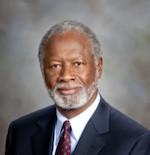Voters casting ballots. (Mario Tama/Getty Images.)
Civil rights groups throughout the state have endorsed the proposed Ohio Issue 1 redistricting reform, and argued in favor of it during a town hall held Tuesday night.
The impact of Issue 1 on Black communities has been up for debate in the last few weeks, with Republican officials saying the measure would break up communities and keep Black voters from having the power they should have, whereas Democrats and supporters of Issue 1 say the current system already closes out black voters from positions of power, and the Ohio General Assembly as it stands has not shown an interest in improving the lives of those black communities.
“It’s so disheartening that the politicians have not only committed the egregious act of gerrymandering, but their actions have now disenfranchised thousands of voters for years now,” said Petee Talley, a retired AFL-CIO state officer and leader in the Ohio Unity Coalition, a state affiliate for the National Coalition on Black Civic Participation.
The virtual town hall held this week included representatives from the NAACP of Ohio, the Columbus chapter of the National PanHellenic Council, alumni from the Delta Sigma Theta Sorority, Inc., the Ohio Organizing Collaborative and the faith-based advocacy group The AMOS Project.
Talley has her own experience to use against the current redistricting system, since she says she and her neighbors haven’t been able to vote on a state senate candidate since 2018.
In her district near the University of Toledo, Talley voted for a state senator when she was a part of the 11th District in 2018. But after redistricting took place, about 33,000 of those voters were moved to the 2nd Senate District, which did not have a race in 2022. Redistricting forced their hand once more, when Talley and her neighbors were once again moved to the 11th District under the latest maps.
“Which means that, again, we will not get to vote for the state Senate district representation this year, because Senate District 2 is up for election and not Senate District 11,” Talley told the town hall audience.
But she will be voting for Issue 1 this November, to reform the process and hopefully correct the errors she and others who spoke in the town hall saw when the Ohio Redistricting Commission led the process, she said.
The Ohio Redistricting Commission, as dictated in the current process, is made up entirely of elected officials, including the governor, auditor, secretary of state and legislative leaders from both parties.
Issue 1 would replace them with a 15-member citizens redistricting commission, which would be selected by a bipartisan judicial panel in a vetting process to weed out those with partisan or other vested interests, according to the language of the proposal. The commission would have five Republicans, five Democrats, and five independents.
A yes vote for Issue 1 would institute the 15-member citizens commission, which would then work on maps that would take effect in 2026. A no vote would leave the elected-official-led commission in place, and all current processes would remain the same.
Under the current process, town hall participants pointed out that a Republican staffer was asked whether demographic and racial data were used in a September 2021 attempt at Ohio Statehouse maps. That staffer said he was “instructed” not to include that data in the legislative maps he and fellow staffers drew.
“We did not use demographic data or racial data in the production of our maps,” said GOP staffer Ray DiRossi at the time. “We were directed not to use that data by legislative leaders, and so we did not use it.”
Of the six Statehouse maps adopted by the Ohio Redistricting Commission, five were ruled unconstitutionally partisan by the Ohio Supreme Court. Of the two congressional maps passed by the ORC, both were found to favor the Republican Party in a way that did not reflect the voting trends for the state in the last 10 years, as required in the redistricting process.
Panelists answering questions at Tuesday’s virtual town hall said, contrary to what opponents of Issue 1 say, the status quo would include a block on legislation that would positively impact black Ohioans and a continued focus on “wedge issues,” as Issue 1 supporter and former Ohio Supreme Court justice Yvette McGee Brown said.
“I’ve not heard any of the Republican leadership, until (Issue 1) got on the ballot, talk about helping Black people,” McGee Brown. “This is the oldest okie doke I’ve ever seen, where they start pulling out Black people to tell you ‘oh, this is bad for Black people.’”
For Ohio Organizing Collaborative voter engagement director Deidra Reese, the voices that are lost in gerrymandering the state are those begging for help with education, prescription drug cost capping, transportation services, infrastructure needs and library services, among other things Black communities and many others are asking the legislature to support.
“There are things that come right down to our home communities, that are right in front of us … that could be addressed in our communities, but we are shut out,” Reese said.
For Talley, simply being able to vote for candidates can make lives better, and she doesn’t see that happening in the current process.
“We have got to stand up and say ‘enough,” Talley said. “We can’t get in the game if we continue to allow for these gerrymandered maps to stand.”
• • •• • •
This story is provided by Ohio Capital Journal, a part of States Newsroom, a national 501 (c)(3) nonprofit. See the original story here.



















